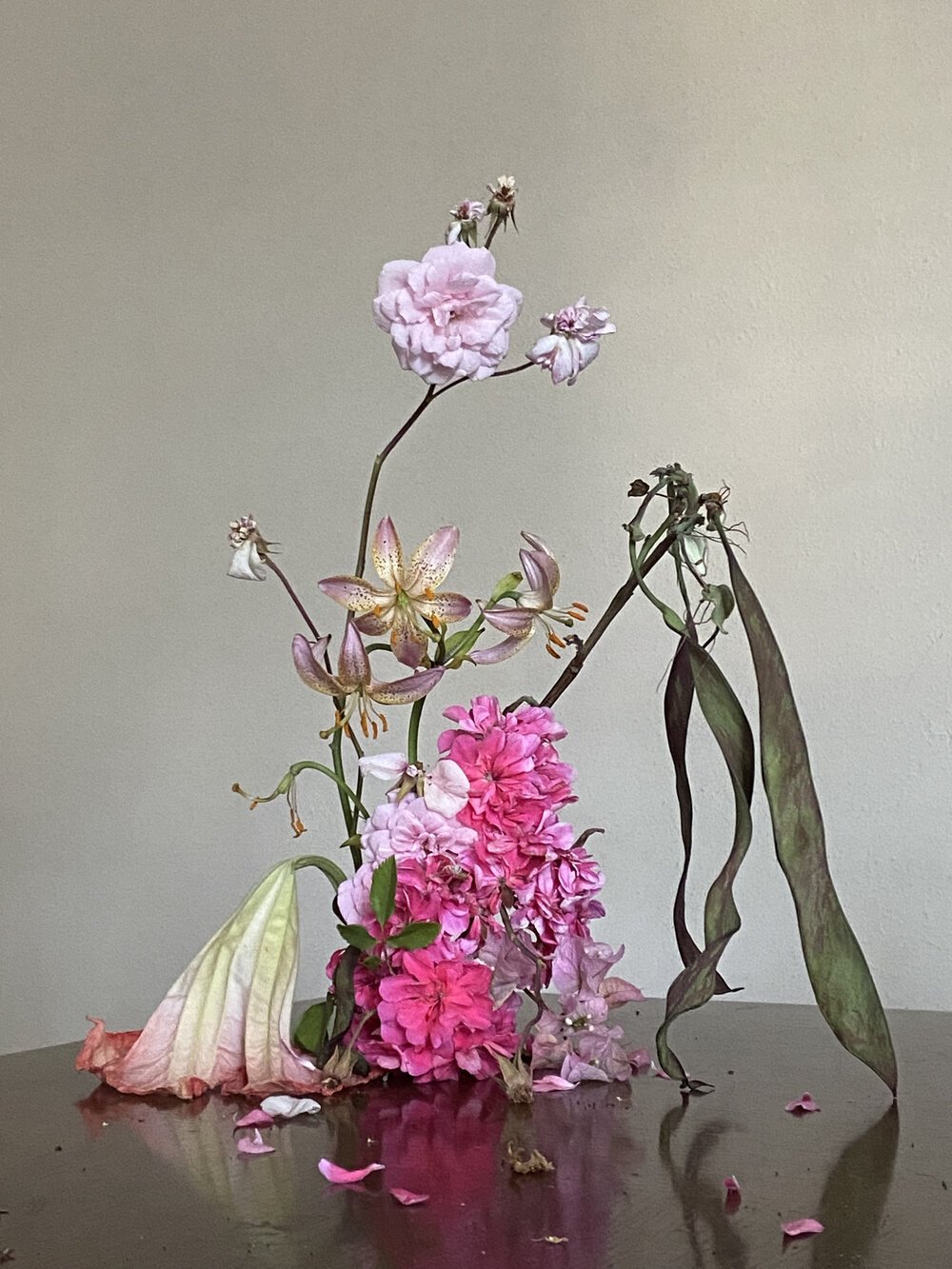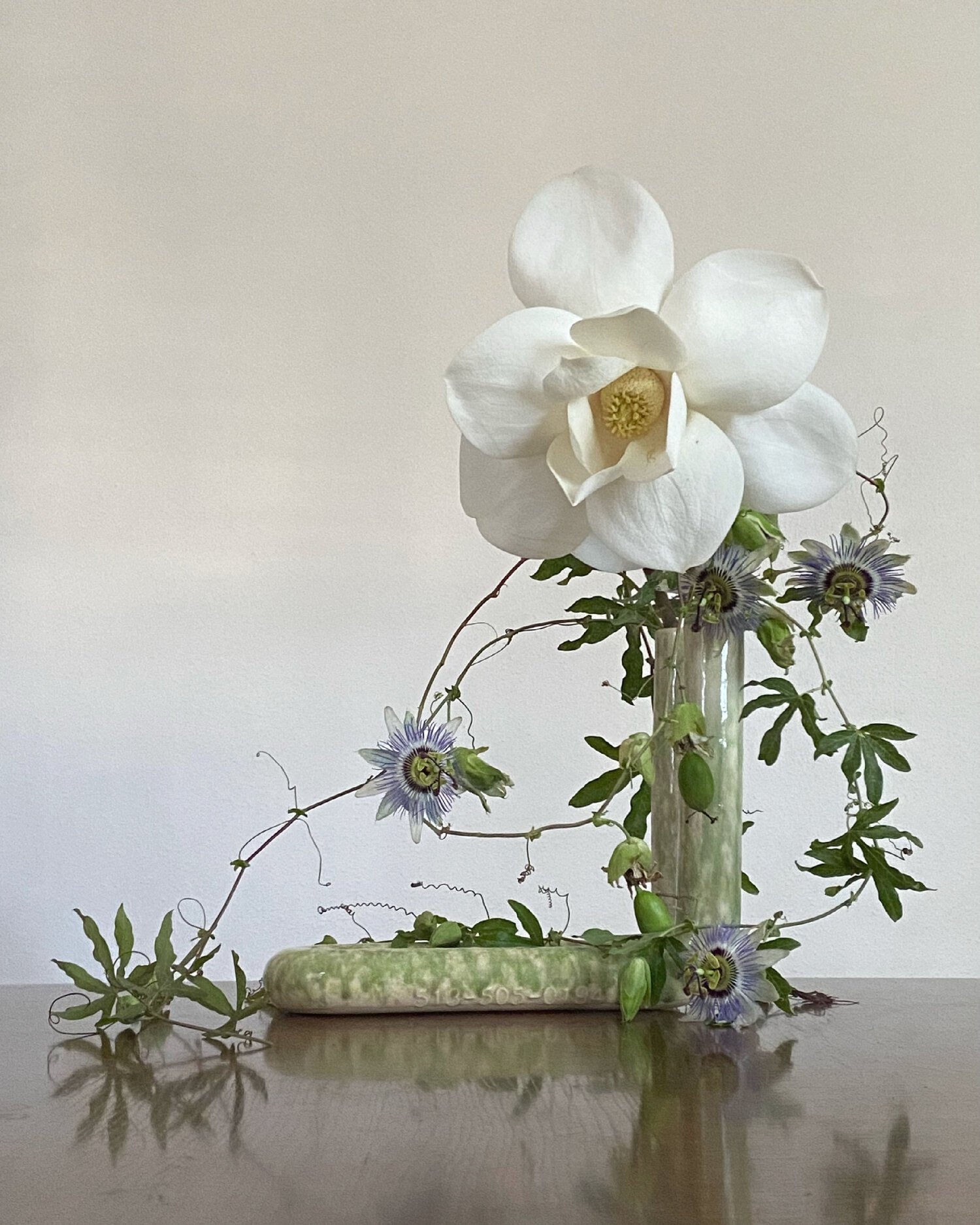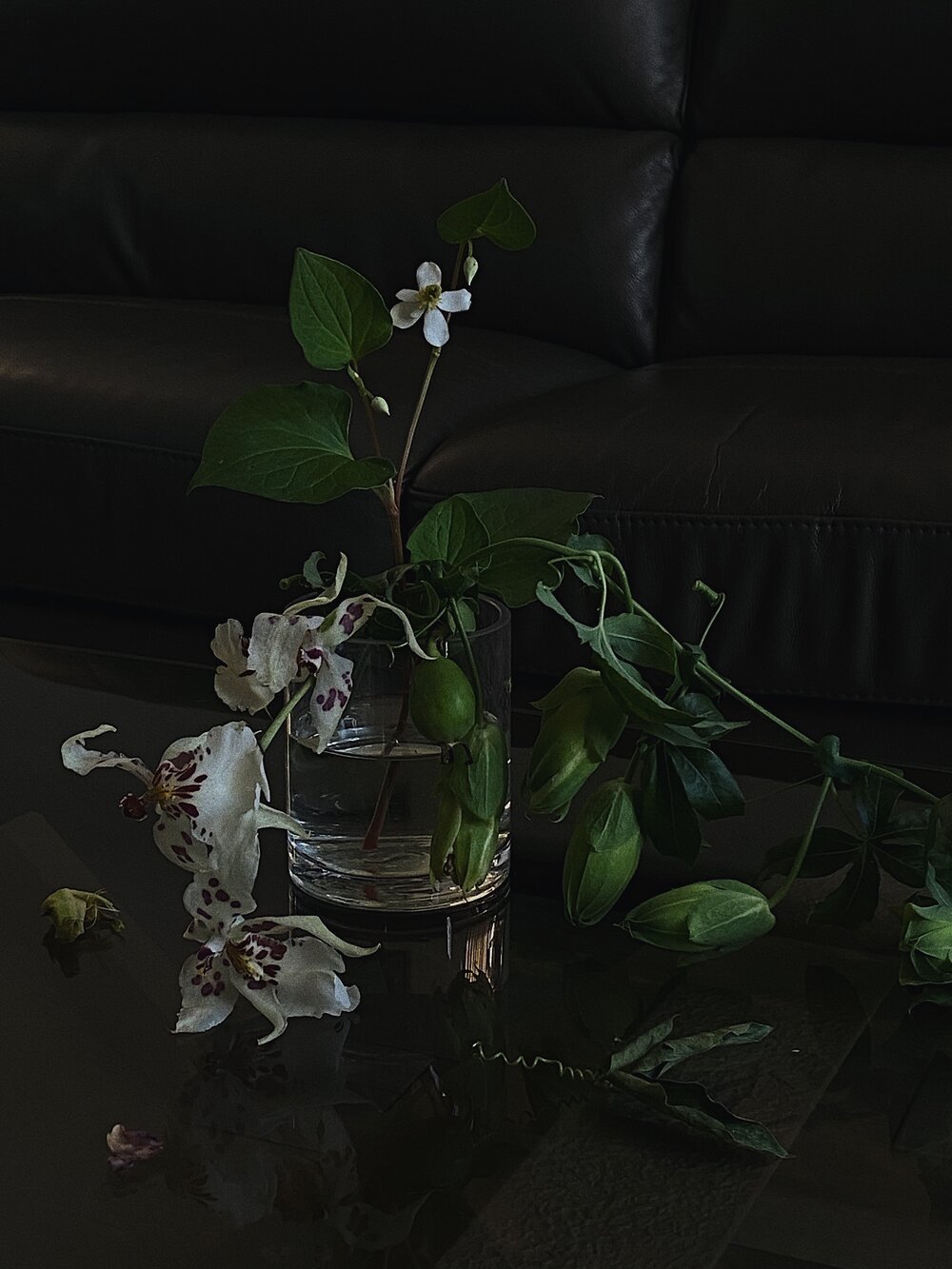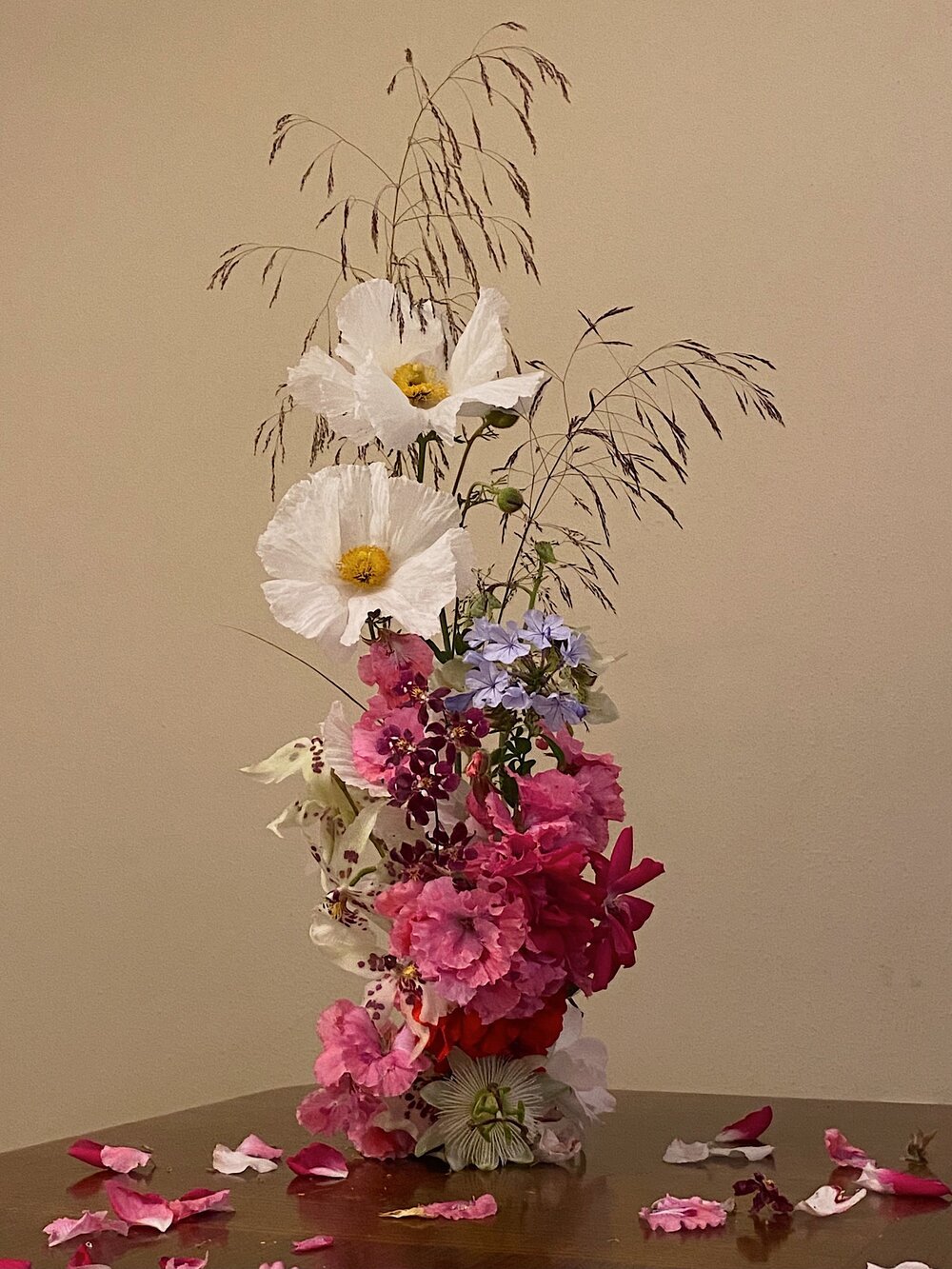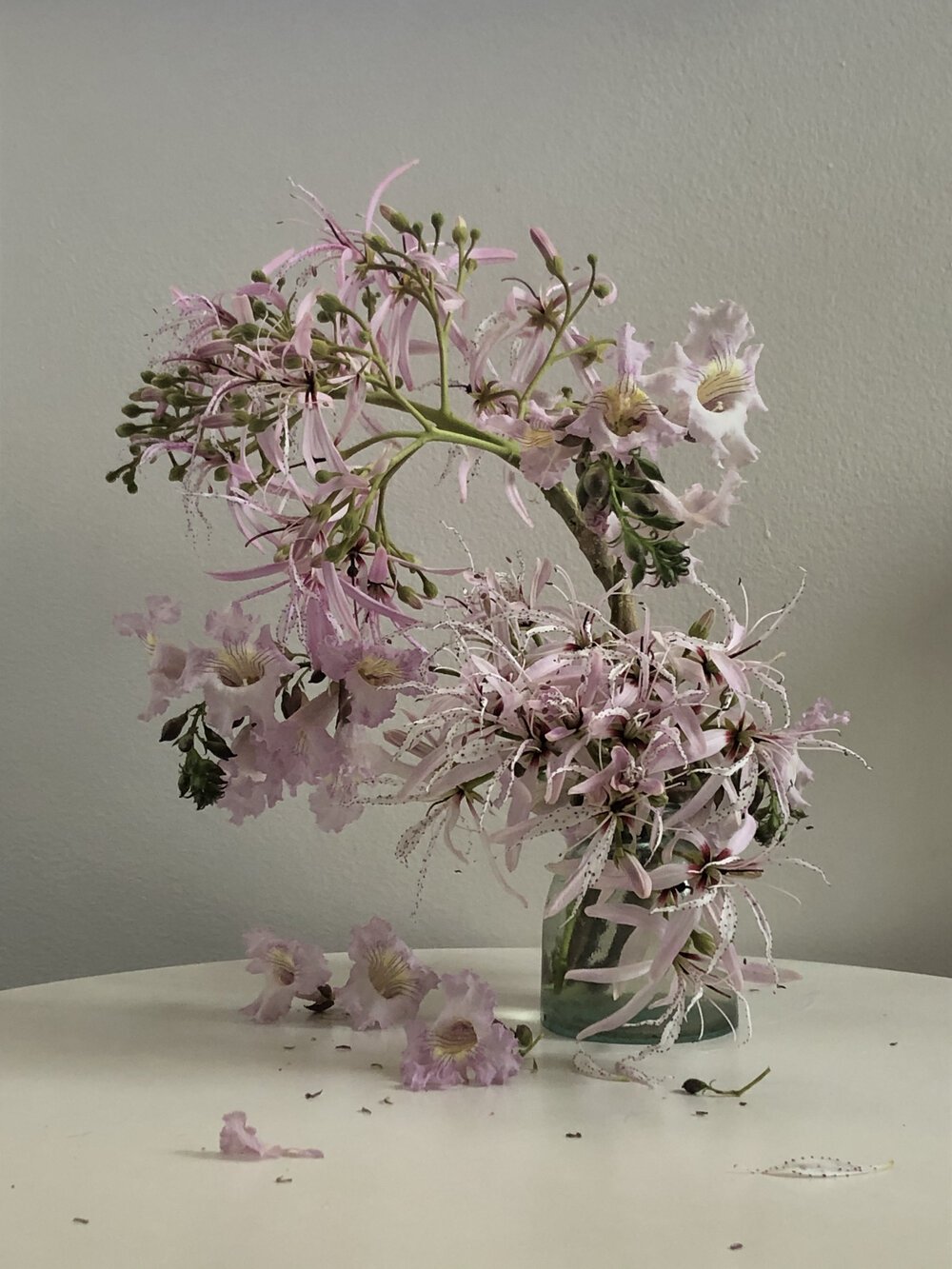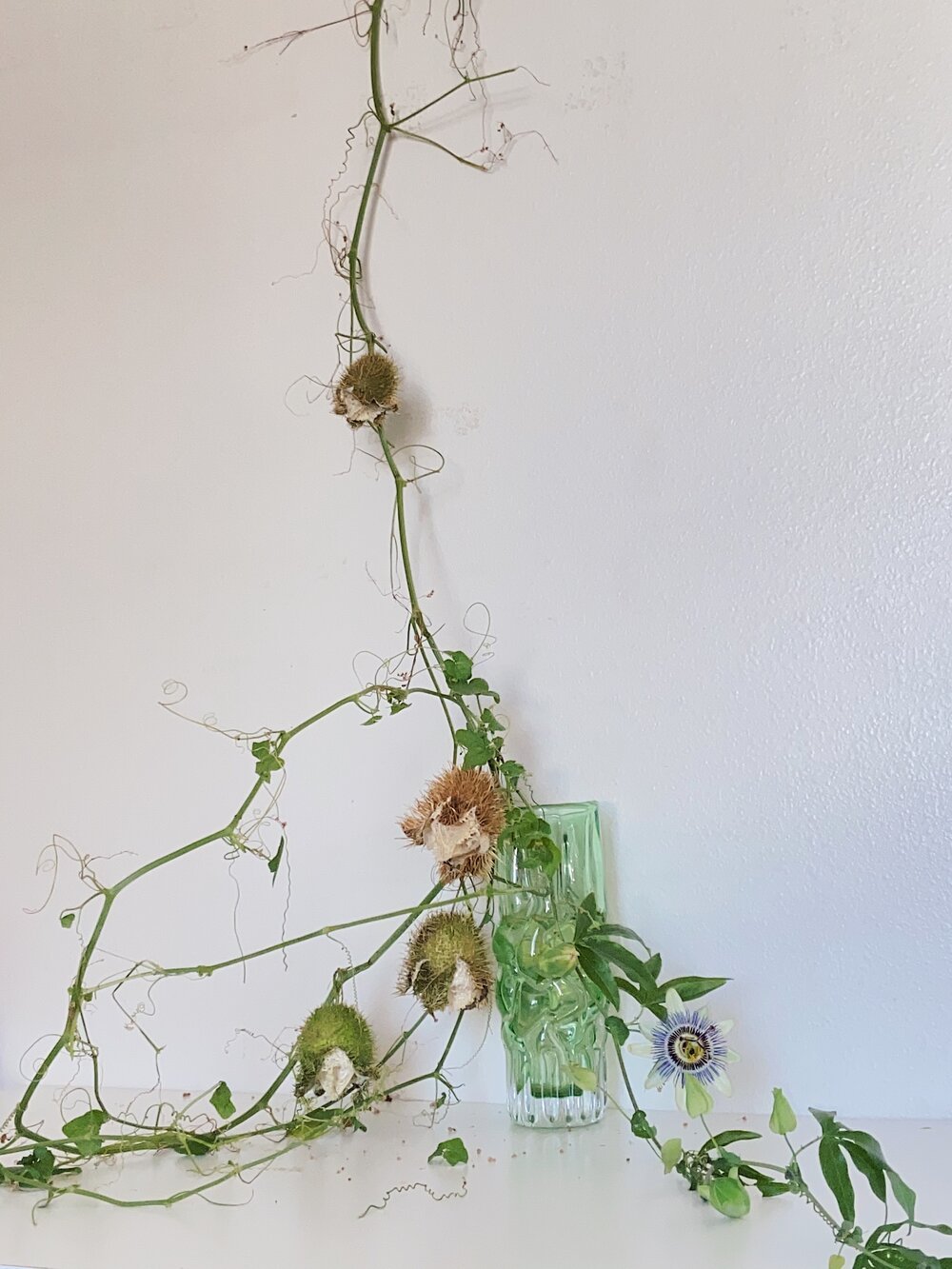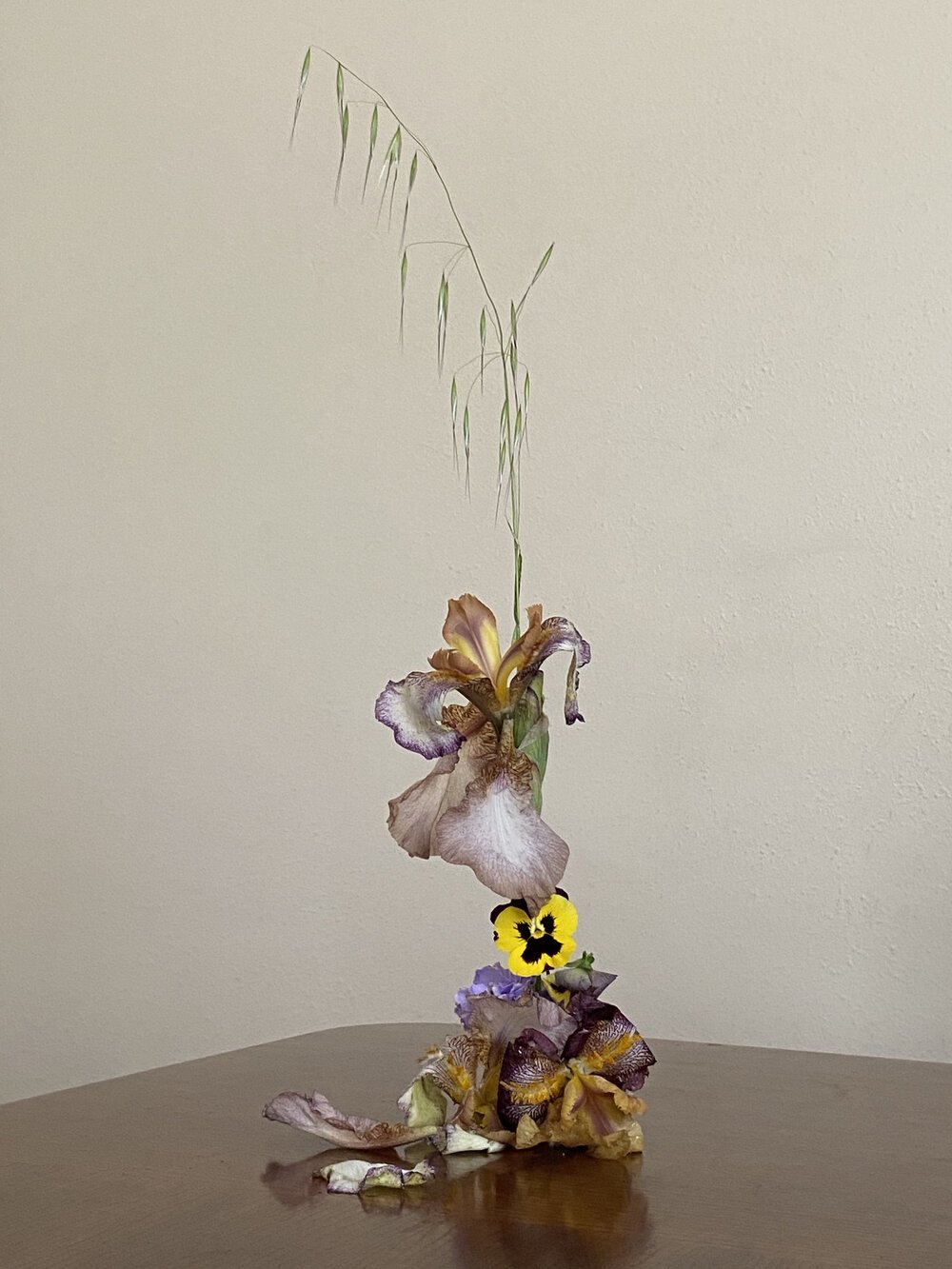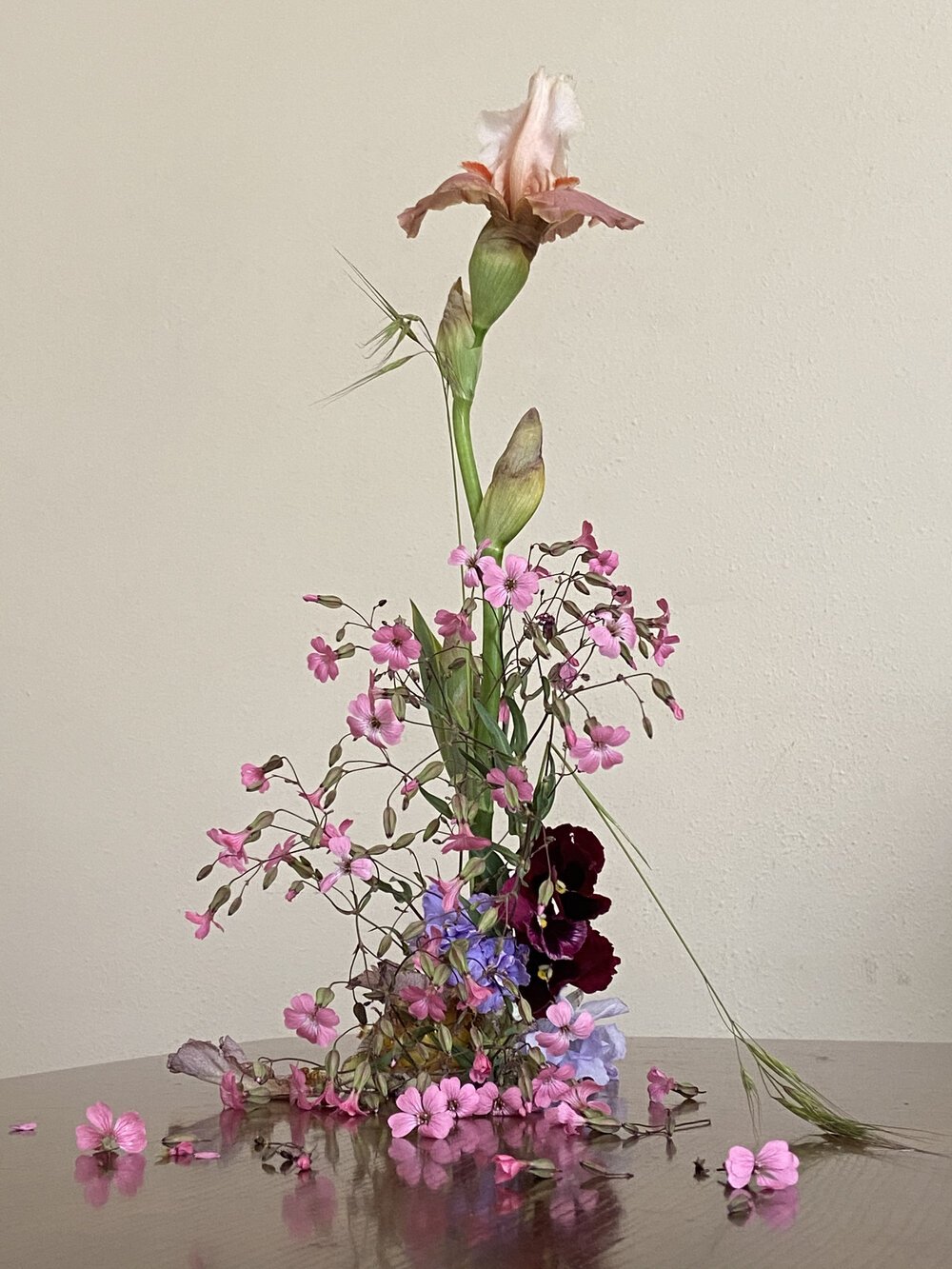Amber Lu
Florist Amber Lu builds flower towers — sculptures made of blooms and branches that seem to defy gravity. Her arrangements are economical, often composed of only a few select elements that stand, hover, and slump against each other to produce tension and harmony. Amber’s work is high impact; she creates intensely emotional pieces by exercising maximum restraint. The Japanese flower arranging art of ikebana, which emphasizes shape, line, and form in mostly minimal compositions, is a clear influence. But there’s also a distinctly Los Angeles flavor to her work. The landscape of the city features extremes of excess and deprivation: lush gardens spilling onto buckling sidewalks, manicured lawns sharing zip codes with dirt yards, bright colors loud against bleached backdrops. Amber’s compositions capture some of this dissonance. The contrast between a fading flower and an almost garishly perfect specimen creates poetic drama. Petals scattered in the foreground of an arrangement mark the passage of time, an inconvenience seldom acknowledged in the floral industry, where installations are dismantled as soon as they show signs of their fleeting nature.
I am most drawn to the flower studies Amber posts on Instagram, made at home after a day’s work putting designs together for other people. They are assembled from the leftovers of those jobs and the detritus of her neighborhood. The images she shares feel like diary entries. When I spoke with Amber I was not surprised to learn she originally planned to become a photographer. She documents each arrangement with precision, transforming quotidian elements — the beige of her apartment wall, the gloss of a countertop, the fading light before dusk — into spare fields of muted color. The setting is banal and the flowers are breath-taking, making the interplay of registers charged and evocative. It’s that electric energy that makes each frame feel like a still from movie, loaded with narrative possibility and a kind of Hollywood heartache.
Vase by Alex Reed
Did you expect to have a creative career?
I’ve always expected to have a creative career. It was hard because growing up in a strict Asian household with a different traditional mindset, anything creative/art-related wasn’t seen as a career path. I’ve always felt I wasn’t set to stick to one job and that being the only job for the rest of my life — I think it’s good to try different things that speak to you and actually fulfill you in that moment.
How did you get started working with flowers? What has your journey been from assisting to leading your own projects?
I was dedicating most of my time to photography and wanted to become a photojournalist. When I finished at Academy of Art in San Francisco, I’m not sure what happened, but I didn’t want to keep pursuing it anymore. I moved back to Los Angeles and needed a job and a nearby flower shop was hiring. I really wasn’t expecting to fall so deeply in it or having it as my career — a huge part of my life actually. After learning from “traditional” designs to romantic garden, etc. — you name it — and working at two different flower shops, I eventually met various florists and they were so kind with open arms to help me through it all.
Assisting to leading my own projects has had its many ups and downs. It still does to this day. It’s so wonderful learning from different florists — how they work, what they envision, them building their business from the bottom up — it’s all so beautiful to watch. I’m forever grateful for those who’ve been there and helped me along the way — past and present.
As to leading and working on my own work, I really had to make time. I assist and freelance so much, sometimes it gets hard and you lose sight of what your work is like and who you are. I had to keep pushing myself and just letting things just be. After a long day, I would find myself trying to make any tome making something even from scraps — it really helped ease my heart in a way. Even seven and a half years in, I’m still learning so many things — about flowers, life, myself. There’s always something new!
Is there something specifically “LA” about the way you build arrangements?
For a lot of my personal work, I try to mostly forage (responsibly and respectfully) flowers and foliage that are in season in Los Angeles. I like to take walks around my neighborhood and see what grows around each season and the same at the flower market. One tree in particular that grows all over in LA is called pink tabebuia trumpet trees - they bloom everywhere on the streets in late fall to spring. Most of these flowers can be found in other cities, but there’s something special about finding these gems amongst others in the streets of Los Angeles – it’s surreal.
Do you have early plant memories or encounters that have shaped your sensibility?
Growing up, my parents planted a plum tree in front of the house I grew up in. It was planted the moment we had moved in. It grew beautifully and healthy all whilst the family was growing up.. I would always be so excited when it would start to flower then produce the most delicious plums. It was my favorite time of the year. As years passed, it started to not do so well. We didn’t know why - my mom took care of it as best she could, but still we were unsure what was happening. It started to produce less plums, it didn’t flower as much, and slowly, it was getting worse and it was cut down. This tree that I grew up with made me understand, and as cliche as it may sound, that this is the cycle of life. Sometimes, things can happen unexpectedly and can happen tragically. I think in some ways, because of this tree and fond memories around it, I include the process of decaying flowers as part of my work because all throughout, it’s still beautiful from the moment it is planted, the beginnings of its growth, to it fully blooming, being cut into a vase, and then slowly wilting – it reminds me of the family plum tree and the memories surrounding it.
How do you think about decay in your practice?
I think decay is just as beautiful as a living flower/plant. It’s life – as one will always say. Sometimes I would like a specific flower to last forever, but to watch it go through waves of “life” in the next hour or a couple of days, it’s as if you were alongside this flower through most of its life. There are so many feelings when capturing its process – the vulnerability, how the colors change, how the petals and stems start to slowly wilt, all of it — I think they deserve a moment just as a fresh flower would have.
How do you think about sustainability in the world of floral design?
It’s tricky because it’s not as sustainable as one thinks it may be - for example - a lot of waste occurs. One can create a beautiful installation with all of the flowers that have been bought which most are purchased at the flower market. Most of the bunches are wrapped in plastic, tied with rubber bands, etc and are used to create a beautiful moment and the next day, it has to be taken down and all of them are thrown away. A lot of hard labor goes into designing/installing, and breaking down. There are some aspects that can be helpful such as reusing the flowers, separating it from trash to compost - little things count, but there’s just so much more to try and do to keep up with sustainability. This industry is very wasteful sadly. It’s best to keep being mindful to the environment, such as not using sprayed/dyed flowers, flowers that are heavily sprayed with pesticides because they are not compostable, floral foam which is the most absolute harmful thing for the environment (please don’t ever use it, there are so many tools to use for mechanics!) use as many local flowers as possible, which can be tricky sometimes when it comes to clients/orders, etc to fulfill them, but researching local farmers that you can possibly order flowers and ways to support their farms, and discussing with clients about using more local flowers can be a start of sustainability and help the environment.
Do you live with plants? Do you bring work home with you?
I used to bring a lot of leftovers, scraps – anything home with me. I still do to this day, not as much now, but any little scraps I'll keep with me in my car until I come home to make something. I turned a small section of my kitchen into an orchid island. Clematis vines live in a huge pot on my small front porch and alongside is a vanda orchid hanging on the rail. In the back porch lives a potted ‘apricot candy’ garden roses, a cleistocactus colademonois (monkey tail cactus), and ‘wightii’ begonia.
What are some cycles that define your job?
The constant running (and driving) around, looking, seeing, finding, researching, searching, imagining, planning, processing, cleaning, creating, taking a step back, going back to it, figuring out pricing, communicating, crying, smelling, laughing, being in shock (good and bad), enjoying, appreciating, understanding, and feeling it all.
The arrangements you put together are so distinct and wholly specific to you. What or who were early influences that shaped your aesthetic?
The various studies and techniques of Ikebana definitely has helped shaped my aesthetics. There are so many techniques and little details that go into Ikebana studies, how everything is intentional, and how each tells a story. The many different florists that I’ve worked for over the years, that have taught and guided me, without them, I really would not be the person that I am today and the seasons and what grows in Los Angeles.
Your work makes me feel very viscerally that "less is more." It can be so hard to exercise restraint with flowers! How did you hone your style of high-impact minimalism?
The work I post on my Instagram are like little “gifts” to myself. I’m not entirely sure to be honest how I honed down my style — I guess from constantly playing around with so many scraps and from foraging bits around my neighborhood. I love taking every bit of everything I can find and putting them altogether, creating these small towers. By stacking them on top of each other, I wanted to show case each individual flower and their uniqueness and beauty. I don’t want to take away from who they are.
What are the different flowers speaking to you especially lately? And the perennial classics?
Currently: camellias, stellata magnolias, poppies, orchids, quince and almond blossoms, and (not a flower) spanish moss. Perennial: clematis, columbine, hollyhock, phlox, begonias, bleeding hearts, chrysanthemums, roses, bearded iris, allium, geranium, japanese anemone, nasturtiums, passiflora, pansy, coral bells, tiger and toad lilies, water lilies and wisteria.


